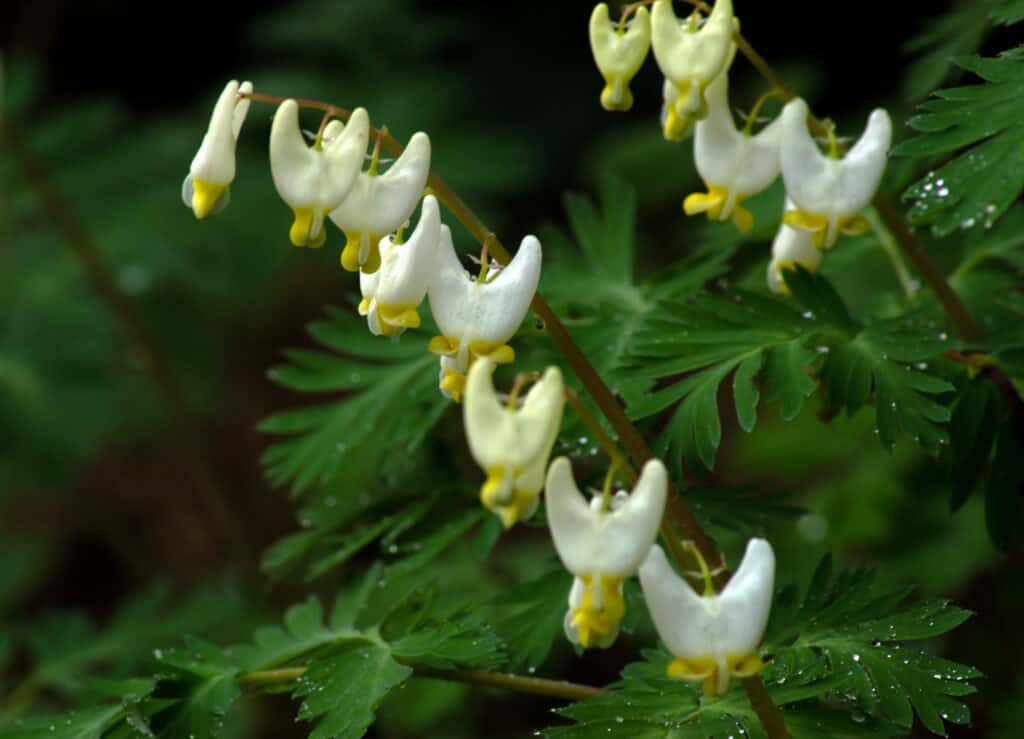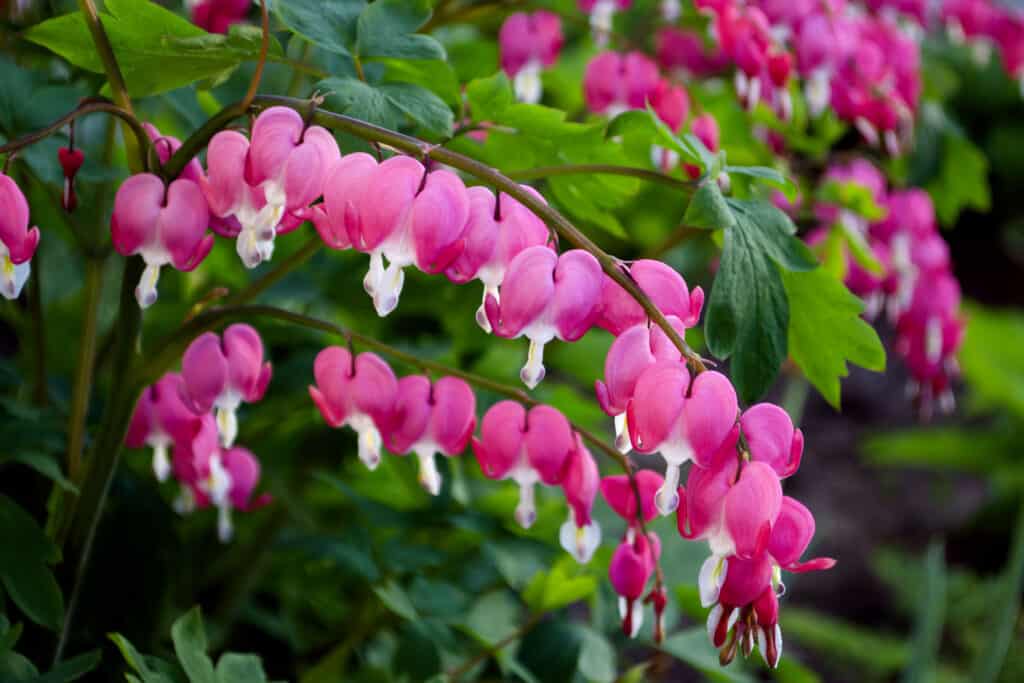While both Dutchman’s breeches and bleeding heart plants hail from the poppy family and display similar flowers and growth habits, they contain several important distinctions. If you’re interested in uniquely shaped flowers, you’ll definitely want to learn about both of these amazing plants, and how to distinguish them. In this guide, we’ll discuss their scientific classifications and the commonalities and distinctions between these plant species. We’ll also cover their uses, what ecological niches they fill, their ideal growing conditions, flowering seasons, and plant care tips. So let’s discover Dutchman’s breeches vs. bleeding heart!
Comparing Dutchman’s Breeches vs. Bleeding Heart
| Dutchman’s Breeches | Bleeding Heart | |
|---|---|---|
| Plant Classification | Dicentra cucullaria | Lamprocapnos spectabilis (formerly Dicentra spectabilis) |
| Plant Description | Perennial with showy, fragrant white or pinkish flowers. Plant height typically reaches between 6 inches and one foot. The triangular, compound leaves are between 3 to 6 inches long and wide. Flowers, which resemble puffy breeches, are ¾ inch long and bloom in clusters of 4-10 along an arching, leafless stem. | Perennial with showy, fragrant pink to red flowers. Plant typically reaches 2 to 3 feet high and 4 feet wide. Stems are fleshy and green to pink. The compound leaves form as three deeply lobed leaflets and the puffy, heart-shaped flowers appear in clusters of up to 10 along an arching, leafless stem. |
| Ecological Niche and Uses | Nectar of flowers attracts various pollinators. Thriving in shady forests, they also make excellent additions to shade gardens. | Attractive to pollinators, hummingbirds and long-tongued bees are particularly suited to accessing the flower’s nectar. Highly valued as a garden ornamental for its stunning flower shape and color. |
| Native Range and Ideal Growing Conditions | Native to forested, humus-rich or rocky areas of eastern North America. Prefers moist, forested, neutral to slightly acidic soil. | Native to Siberia, China, and northern Japan. Introduced into the US in the mid 19th century. Prefers well-draining, humus-rich soil and partial shade. |
| Flowering Season | Only blooms for about 2 weeks in early to mid-spring. | Blooms appear in mid-spring and last for about 4 to 6 weeks. |
The Key Differences Between Dutchman’s Breeches and Bleeding Hearts

Dutchman’s Breeches get their name from their double teardrop shaped bulblets, that look like a pair of white breeches or pants.
©iStock.com/Joshua Moore
The main differences between Dutchman’s breeches and bleeding hearts are the shape and color of the flowers. Dutchman’s breeches have white flowers while bleeding hearts have red or pink flowers. The flowers of bleeding hearts are heart-shaped as opposed to the distinctive breech-shaped flowers of Dutchman’s breeches. The other differences between these two unique plants include their size, native range, and flowering seasons.
Dutchman’s Breeches vs. Bleeding Heart: Plant Classification
Dutchman’s breeches and the common bleeding heart are both a part of the subfamily, Fumarioideae, and the larger poppy family of plants, Papaveraceae. Until the turn of the 21st century, both plants were also a part of the same genus, Dicentra. However, taxonomists reclassified the bleeding heart in 1997 into the Lamprocapnos genus. Frequently, you will still find the common bleeding heart referenced by its former scientific name, Dicentra spectabilis.
As a member of the poppy family, both the Dutchman’s breeches and bleeding hearts contain neurotoxins that can affect the central nervous system of humans and many domestic animals, such as sheep and cattle. Ingestion of this plant can cause symptoms such as staggering, trembling, convulsions, and difficulty breathing. Dutchman’s breeches are also called “little blue staggers” due to the narcotic effect the plant has on unfortunate cattle who graze upon them.
Dutchman’s Breeches vs. Bleeding Heart: Appearance
The key differences between the physical characteristics of these two plants are the shape and color of the flowers and the size of the plant. When telling the two plants apart, remember that the Dutchman’s breeches are much smaller in overall height and spread than its bleeding heart relative.
You’ll also want to take a look at the differences in the flowers. The flowers of the Dutchman’s breeches are distinctly shaped like upside-down pairs of puffy breeches (hence the name). Compare this to the striking (non-anatomical) heart-shaped flowers of the bleeding heart. Also, while the Dutchman’s breeches flowers can have a slight pink tint to them, they are not nearly as strikingly pink-red as the flowers of the bleeding heart.
You can see the commonality of their morphology in the structure of their leaves and the growing habits of their flowers. Notice how both plants produce their droplet-like, puffy flowers in clusters of up to ten along bare, arched, fleshy stems?
Both plants also have compound leaves, which means the leaf is composed of two or more leaflets attached to shorter stems that branch off the main stem. However, Dutchman’s breeches have finer, more deeply lobed leaves whereas bleeding heart leaves are less severely lobed and more rounded.
Dutchman’s Breeches vs. Bleeding Heart: Ecological Niches and Uses
Besides being beautiful to look at, both these lovely plants serve important roles in their environments by attracting and feeding pollinators. The nectar of both plants’ flowers attracts various songbirds, butterflies, and bees. These plants are great additions to a pollinator garden. In particular, long-tongued bees, such as bumblebees, and hummingbirds are well-suited to reaching the nectar of these flowers. The bright pink-red color of the bleeding heart flowers is especially attractive to hummingbirds.
In organically rich forests of the eastern U.S. and eastern Canada, hikers and wildflower enthusiasts can enjoy the short-lived, but gorgeous blooms of Dutchman breeches in early spring. Enjoy admiring, but don’t pick these delicate flowers as they will instantly wilt.
Bleeding hearts are a vastly popular ornamental addition to gardens in the U.S., UK, and eastern Asia. With their showy, fragrant blooms and large bushy foliage, these plants make stunning additions to pollinator gardens and light/partial shade gardens.
Dutchman’s Breeches vs. Bleeding Hearts: Native Ranges and Ideal Growing Conditions
While these two plants have many similarities, their native ranges are across the world from each other. Dutchman’s breeches are native to humus-rich (referring to the organic components of soil), moist, and forested regions of the eastern US and Canada.
The bleeding heart is native to the cool regions of Siberia, China, and northern Japan. There are two native varieties of bleeding hearts to the US- one to the Appalachian mountains (Dicentra eximia) and one to the Pacific Northwest (Dicentra formosa) – but the Asian variety is the most commonly grown in ornamental gardens.
In fact, Japanese folklore tells a creation story of the bleeding heart plant. In it, a young suitor gives his love interest gifts that she accepts with the caveat that she doesn’t love her courter. Finally, the suitor, with nothing left to give to the young woman, stabs his own heart out of grief. In the story, the first bleeding heart plant then grows from the ground where the young man dies. The gifts the suitor bestows upon the young woman- a pair of white rabbits, white slippers, and white earrings- represent the inside layered parts of the flower, which are surrounded by the outer pink heart.
While both Dutchman’s breeches and bleeding hearts can survive in shaded gardens, Dutchman’s breeches thrive in the shade while bleeding hearts prefer partially shaded environments that allow about four hours of full sun.
Both plants prefer humus-rich, moist soil, but bleeding hearts particularly require well-draining soil. They are prone to root rot if grown in poorly-draining soil. Dutchman’s breeches are hardy in US growing zones 3-7 and bleeding hearts are hardy in US growing zones 3-9.
Dutchman’s Breeches vs. Bleeding Hearts: Flowering Seasons

Bleeding heart plants bloom for approximately 4 to 6 weeks.
©iStock.com/Oksana Akhtanina
Both plants have fairly short-lived blooming seasons in early-to-mid spring, but Dutchman’s breeches are exceptionally short at only about two weeks of flowering. If you want to admire these beauties in the wild, you’ll need to make sure that you accurately time your trek into the woods. Bleeding hearts will produce their stunning flowers for a longer period of about 4 to 6 weeks.
Both plants are spring ephemerals, which means their life cycles above ground only last a few short weeks before the flowers, stems, and leaves fully die back by early-to-mid summer. The plants have a robust life cycle underground as well before they re-emerge again in the spring.
As such, if you plant either of these beauties in your garden, you may want to place them near a larger plant or quick-growing ground cover that can fill in the space they will leave behind by mid-summer.
Ductchman’s Breeches vs. Bleeding Hearth: Growing Considerations
Growing Dutchman’s breeches from seeds is a fairly intensive process as the seeds don’t survive drying out and require exposure to cold, then warm, and then cold again for germination. An interesting fact is that Dutchman’s breeches seeds in the wild are typically dispersed by ants who carry the seeds to their nests. The ant nest provides an ideal environment for the seeds over winter and the ants benefit from nutrients found in the fleshy exterior structure of the seeds.
Propagation by bulbs is simple, however, and conservationists encourage gardeners to propagate from their gardens or nurseries to protect wild Dutchman’s breeches populations. If you’re growing Dutchman’s breeches in an area with wildlife, you might be relieved to know this plant is deer-resistant!
The common bleeding heart is much easier to propagate than Dutchman’s breeches by seed, cuttings, or dividing. Bleeding hearts can self-seed under moist conditions. If making cuttings from stems or roots, wait until after flowering. Neither of the plants are drought-resistant. Ensure when you care for these delicate plants that they receive weekly watering, especially before and during flowering.
Up Next:
- 5 Perennial Flowers For Shade
- 15 Best Potted Annual Flowers to Attract Pollinators
- 15+ Deer Resistant Perennial Flowers
The photo featured at the top of this post is © iStock.com/Oksana Akhtanina
Sources
- Shenandoah National Park, Available here: https://www.nps.gov/shen/learn/nature/dutchmans_breeches.htm
- Department of Horticulture, Available here: https://www.uky.edu/hort/Leaf-Collection-Leaf-Shapes
- North Carolina State Extension (1970) Dicentra cucullaria (Dutchman's Breeches, Dutchman's Britches) | North Carolina Extension Gardener Plant Toolbox (ncsu.edu)
Thank you for reading! Have some feedback for us? Contact the AZ Animals editorial team.






